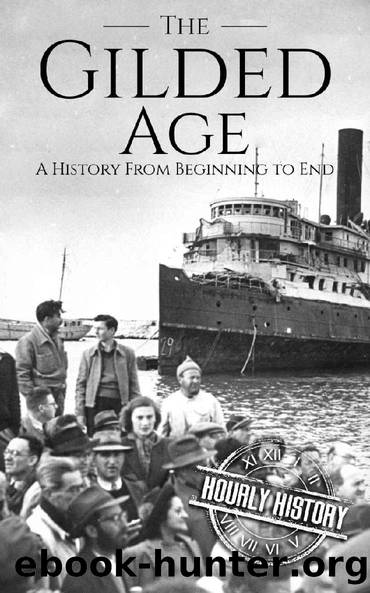The Gilded Age: A History From Beginning to End by Hourly History

Author:Hourly History [History, Hourly]
Language: eng
Format: epub
Publisher: Hourly History
Published: 2019-01-28T00:00:00+00:00
Chapter Six
Emergence of Labor Unions and Womenâs Movements
âWe mean to uphold the dignity of labor.â
âPart of the initiation oath for the Knights of Labor
Given the substandard working conditions which faced most working-class people, it is logical that the Gilded Age also saw the rise of popular labor movements in the United States. The first large labor union in the U.S. was the National Labor Union, founded in 1866. The NLU attempted to engage in collective bargaining with business owners to increase wages and improve working conditions. However, the NLU was hampered because the large numbers of immigrants and the influx of people to cities meant that employers could afford to dismiss workers who threatened to strike and replace them with others who were not affiliated with a union. The NLU was further impeded because it did not allow women or black people to join. The NLU lasted just six years, and during the Panic of 1873, it effectively ceased to exist.
The Knights of Labor began as a secret workersâ society in 1869, but it became a labor union after the failure of the NLU. Unlike the NLU, the Knights of Labor allowed membership for both women and black people, and in the 1870s and 1880s it was successful in organizing strikes that led to some improvement in wages and conditions for workers, though just like the NLU it was hampered by the widespread availability of non-union labor. By the mid-1880s, the Knights of Labor had over 700,000 members.
The reaction of employers to strikes during the Gilded Age was often violent and sometimes brutal. In May 1886, at a gathering of workers involved in a strike organized by the Knights of Labor in Chicago, police opened fire and killed several strikers. At a demonstration the following day at Haymarket Square in Chicago, someone threw a bomb as police advanced to disperse demonstrators. Seven police officers and four protestors were killed in the bomb blast and an ensuing exchange of gunfire. Several members of an anarchist group were arrested and accused of the bombing, and the Knights of Labor were also (falsely) accused of involvement. The following year, the Knights of Labor organized a strike of sugar cane workers in Louisiana. As a result of the strike, many black workers and their families were evicted from their homes, and a large number sought refuge in the town of Thibodaux. While there, the strikers were attacked by white militia groups and up to 50 black men, women, and children were killed. The strikers returned to work without achieving any of their demands, and as a result of this and other perceived failures, the Knights of Labor declined in popularity.
However, as the Knights of Labor were in decline, another labor group, the American Federation of Labor, was growing in popularity. The AFL acted as coordinator for a number of smaller independent unions, though it represented only white, male, skilled workers. Like the labor unions which had come before, the AFL campaigned for shorter working hours, better wages, and improved working conditions.
Download
This site does not store any files on its server. We only index and link to content provided by other sites. Please contact the content providers to delete copyright contents if any and email us, we'll remove relevant links or contents immediately.
Blood and Oil by Bradley Hope(1509)
Wandering in Strange Lands by Morgan Jerkins(1353)
Ambition and Desire: The Dangerous Life of Josephine Bonaparte by Kate Williams(1327)
Daniel Holmes: A Memoir From Malta's Prison: From a cage, on a rock, in a puddle... by Daniel Holmes(1282)
It Was All a Lie by Stuart Stevens;(1241)
Twelve Caesars by Mary Beard(1223)
The First Conspiracy by Brad Meltzer & Josh Mensch(1124)
What Really Happened: The Death of Hitler by Robert J. Hutchinson(1113)
London in the Twentieth Century by Jerry White(1096)
Time of the Magicians by Wolfram Eilenberger(1073)
Twilight of the Gods by Ian W. Toll(1066)
The Japanese by Christopher Harding(1065)
Cleopatra by Alberto Angela(1043)
A Woman by Sibilla Aleramo(1040)
Lenin: A Biography by Robert Service(1024)
The Devil You Know by Charles M. Blow(969)
Reading for Life by Philip Davis(954)
1965--The Most Revolutionary Year in Music by Andrew Grant Jackson(906)
The Life of William Faulkner by Carl Rollyson(898)
